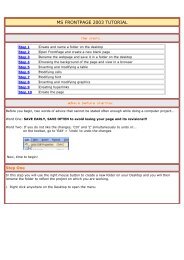

- #MICROSOFT FRONTPAGE 2003 TUTORIAL PART FULL#
- #MICROSOFT FRONTPAGE 2003 TUTORIAL PART CODE#
- #MICROSOFT FRONTPAGE 2003 TUTORIAL PART FREE#

Use this feature sparingly, as it's not necessarily 100% accurate. Preview is a page preview function, intended to display your page exactly as a browser would. To hide the tags, select View » Reveal Tags again. FrontPage peppers your page with yellow tag markers to give you a glimpse behind the scenes. With the document window in Design view, select View » Reveal Tags.
#MICROSOFT FRONTPAGE 2003 TUTORIAL PART CODE#
If all that code is too much for you, check out an additional "light" option.
#MICROSOFT FRONTPAGE 2003 TUTORIAL PART FREE#
#MICROSOFT FRONTPAGE 2003 TUTORIAL PART FULL#
To do so, select Tools » Customize, click on the Options tab, and then turn on the Always Show Full Menus checkbox. Until you're more familiar with the program, you will probably want to see all the options at once. If you leave them active, you'll notice that they display only your most recent selections. Abbreviated menus are the standard setting in FrontPage, and they are sometimes called customized or personalized. Or you can click the double arrows at the bottom, as shown in the illustration, if you're impatient. If you hold the menu open for a while, all the choices will eventually show up. When you click on a menu heading, a list of basic choices appears, while the rest of the menu list is hidden. This feature is designed to save time, but can be frustrating. How can I turn off those mini-menus that don't show me all my menu options?

These page view buttons let you look at your page in different formats. Your choices are described next.įigure 1-2. Buttons on the lower-left corner of the document window, pictured in Figure 1-2, let you change the way this window shows your page. This is your canvas, where you'll create and edit your Web pages. The screen is dominated by the document window, in which you'll do most of your work.

Select View » Toolbars to add or hide FrontPage toolbars. You'll probably want to keep these toolbars around, but if not, you can get rid of them. Hold your cursor over a button to display its function. These two get top billing because they contain the most commonly used commands. Two toolbars Standard and Formatting display the first time you open FrontPage. (See Appendix A for a detailed explanation of every menu.) They follow the basic layout of Microsoft menus. For example, the task pane, shown on the right side, presents new options, based on what you're doing. As you perform different tasks, the window's layout changes. When you first open FrontPage, a window like this appears. Below that, toolbars feature shortcut buttons to menu commands.įigure 1-1. This familiar setup, pictured in Figure 1-1, features a menu along the top of the screen. The Front3 editing window looks similar to that of other Microsoft products, so if you're familiar with programs like Word and Excel, you'll be at home in FrontPage.


 0 kommentar(er)
0 kommentar(er)
